CORRELATIONS BETWEEN THE DSM-IV CATEGORICAL MODEL AND THE ALTERNATIVE DSM-5 MODEL
Abstract
Introducere: Diversitatea trăsăturilor de personalitate și rigiditatea modelului categorial al tulburărilor de personalitate a favorizat introducerea unui model nou dimensional in DSM 5. Obiective: scopul acestui studiu a fost găsirea unor corelații între trăsăturile modelului categorial și fațetele modelului alternativ DSM-5, descrierea celor 6 tulburari de personalitate nedescrise din perspectiva acestui model si testarea reliabilitatii inventarului PID-5 la nivelul domeniilor. Metode: in studiul nostru am inclus un grup de 155 de studenți (n=155) care au completat ”Chestionarul tulburărilor de personalitate 4” (PDQ-4) și ” Inventarul de personalitate pentru DSM-5” (PID-5). Rezultate: am găsit corelatii pozitive puternice între trăsăturile de personalitate schizoide și detașare (r=0,61; p= 0,0001); între trăsături de personalitate schizotipal și psihoticism (r=0,61; p=0,0001); între tulburări de personalitate evitante și afectivitate negativă (r= 0 60; p= 0,0001). Reabilitarea a fost evaluată prin factorul alfa al lui Crombach. Inafara domeniului dezinhibitțe (alfa=0,65) am constatat indici de reliabilitate cu valori alfa peste 0,7. Concluzii: modelul alternativ DSM-5, prin cele 25 de fațete ale lui, devine astfel un instrument important in evaluarea profilului personalitatii.
INTRODUCTION
The introduction of a dimensional model for personality disorders in DSM-5 demonstrates the tendency of the contemporary psychiatry to see the personality traits in a continuum. Contrary to the categorical approach, which has the advantage of facilitating the communication between specialists, the dimensional approach is focused on understanding the intrapsychic mechanisms of the individual and on assessing the personality profile as detailed as possible. When introducing this alternative DSM-5 model, it started based on the Big Five model and it ended up as a version containing 25 pathological traits, called facets, which are grouped in 5 domains. The alternative DSM-5 model offers us as well solutions to pass to the categorical approach, the 6 personality disorders being described through the 25 traits of this model. (1)
OBJECTIVE
Our purpose has been:
-to study the correlations between the DSM-IV categorical model(2) and the facets of the alternative DSM-5 model.
-to describe the 6 personality disorders that have not been described from the perspective of this model: Schizoid PD, Paranoid PD, Histrionic PD, Dependent PD, Passive- Aggressive PD, Depressive PD.
-to determine the reliability of the Personality Inventory for DSM-5 at the level of domains.
MATERIAL AND METHODS
We included in our study a group of students (N=155) who completed an online questionnaire over the period 2013-2016.
In our study we used the data of two self-administered,
online tests: PDQ-4 and PID-5.
Ethical rules regarding informed consent and confidentiality were applied. Data where processed using Microsoft Excel (Microsoft Corp., Redmond, WA, USA), GraphPad InStat and PSPP. Linear (Pearson) correlation test was used to calculate the correlation between different dimensions. Cronbach’s alpha factor was used to calculate the internal reliability on the dimension level of PID-5.
RESULTS
Tables 1. and 2. show the correlation coefficients(r) between the personality traits measured by PDQ-4 and the facets of the alternative DSM-5 model measured by PID- 5.
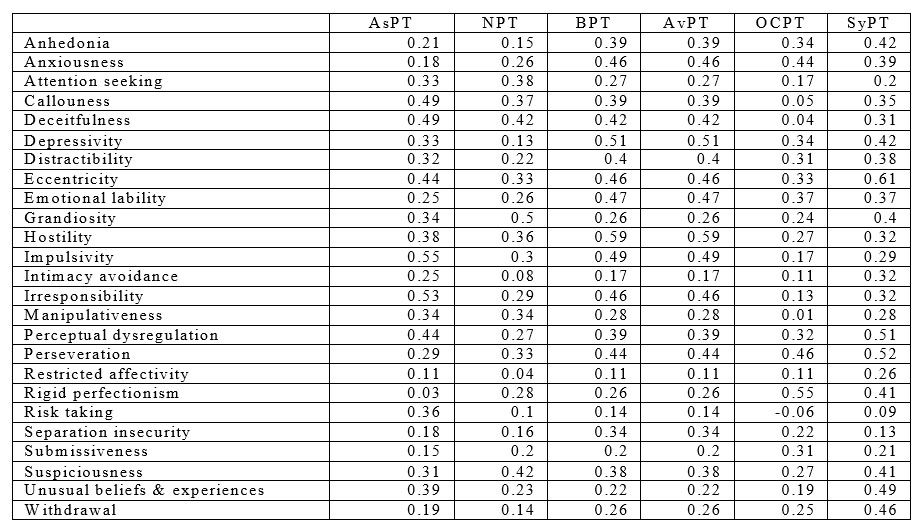
Table 1. Correlations between personality traits of the categorical model and facets of the alternative model for the 6 personality disorders described in the alternative DSM-5 model. AsPT – Antisocial Personality Traits; NPT- Narcissistic Personality Traits; BPT- Borderline Personality Traits; AvPT – Avoidant Personality Traits ; OCPT – Obsessive-Compulsive Personality Traits ; SyPT – Schizotypal Personality Traits;
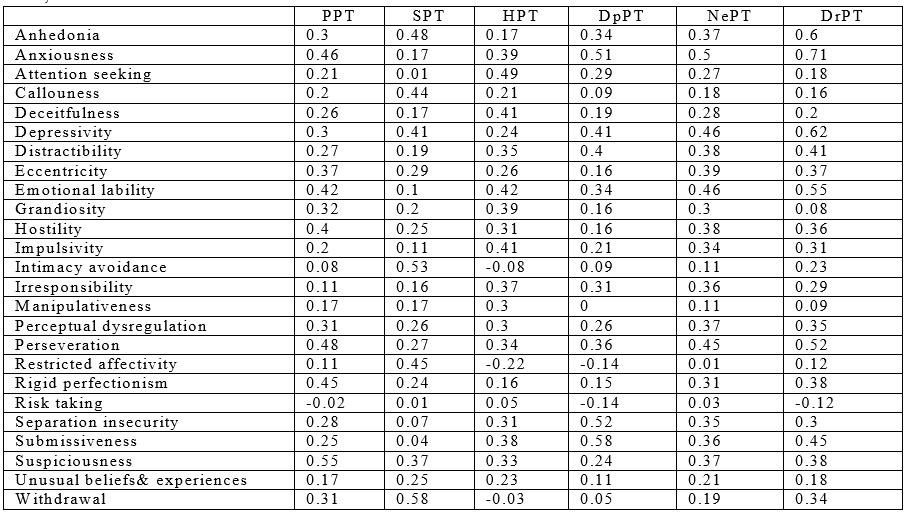
Table 2. Correlations between personality traits of the categorical model and facets of the alternative model for the 6 personality disorders unapproached in the alternative DSM-5 model. PPT – Paranoid Personality Traits; SPT – Schizoid Personality Traits; HPT – Histrionic Personality Traits; DpPT – Dependent Personality Traits ; NePT – Negativistic Personality Traits ; DePT – Depressive Personality Traits;
Bellow we present graphically these correlations
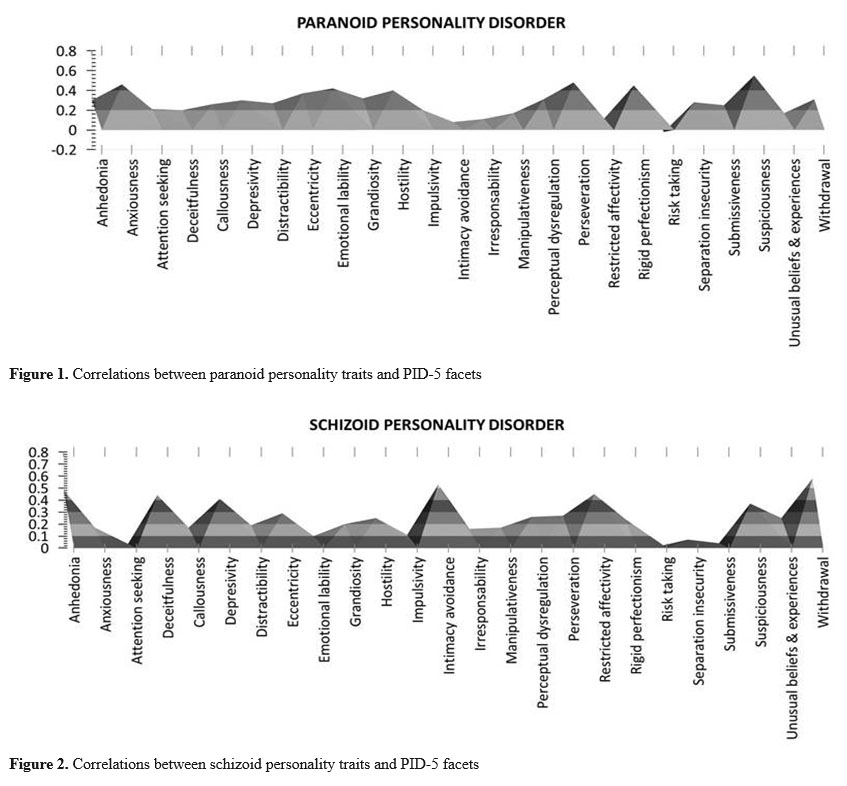
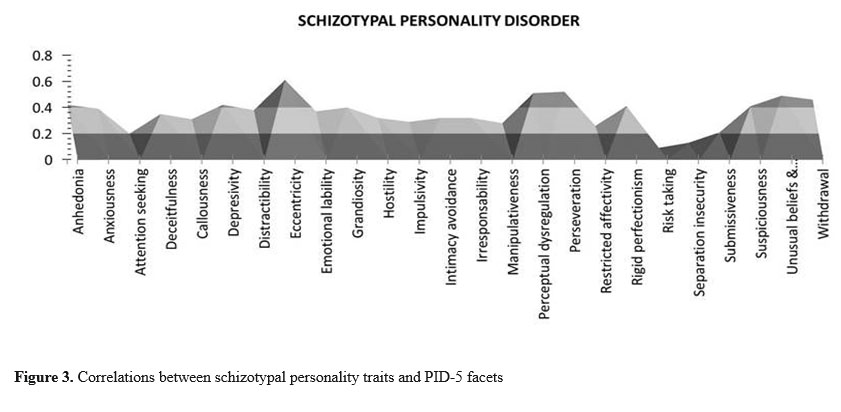
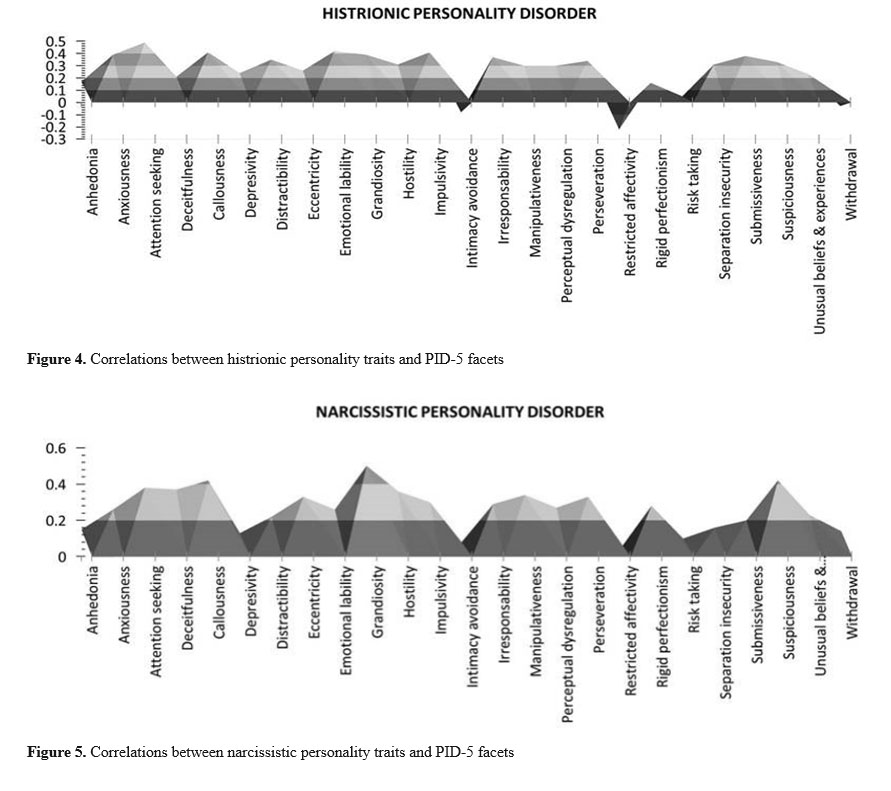
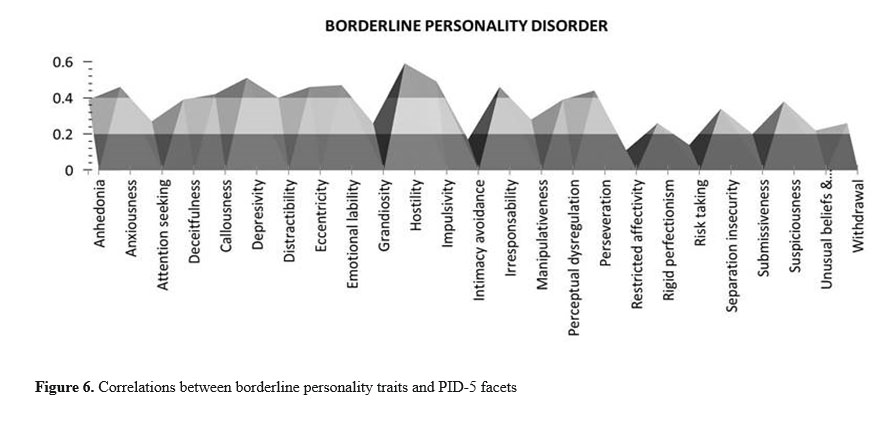
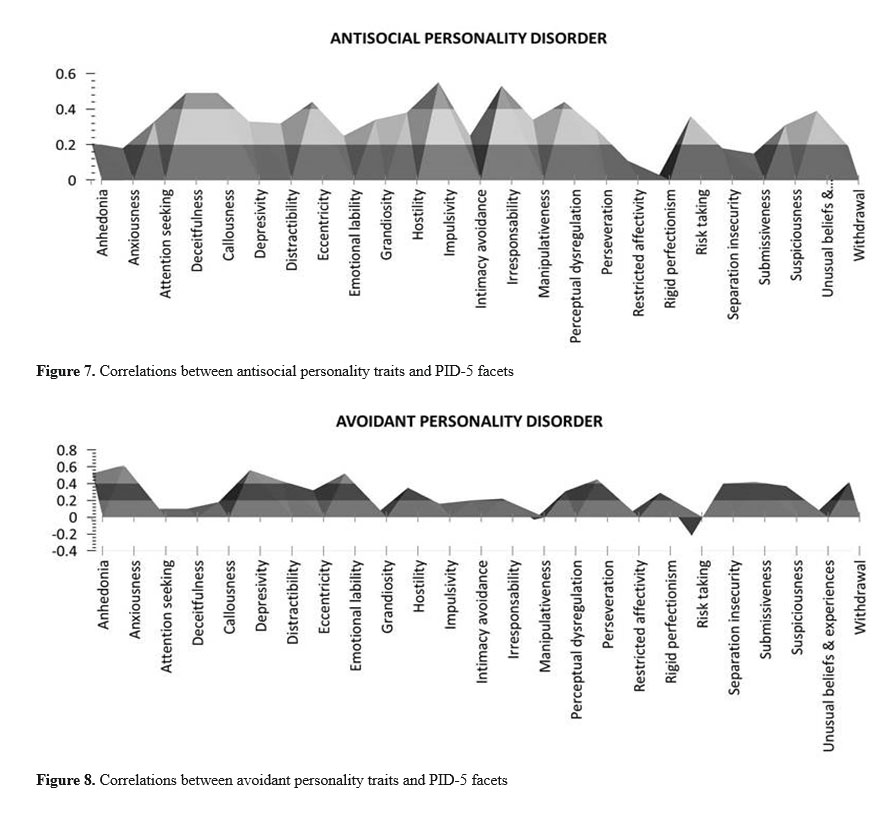
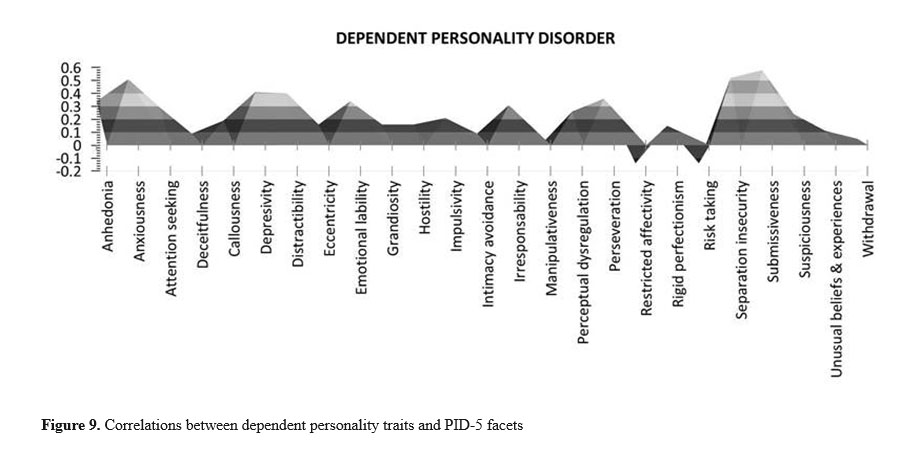
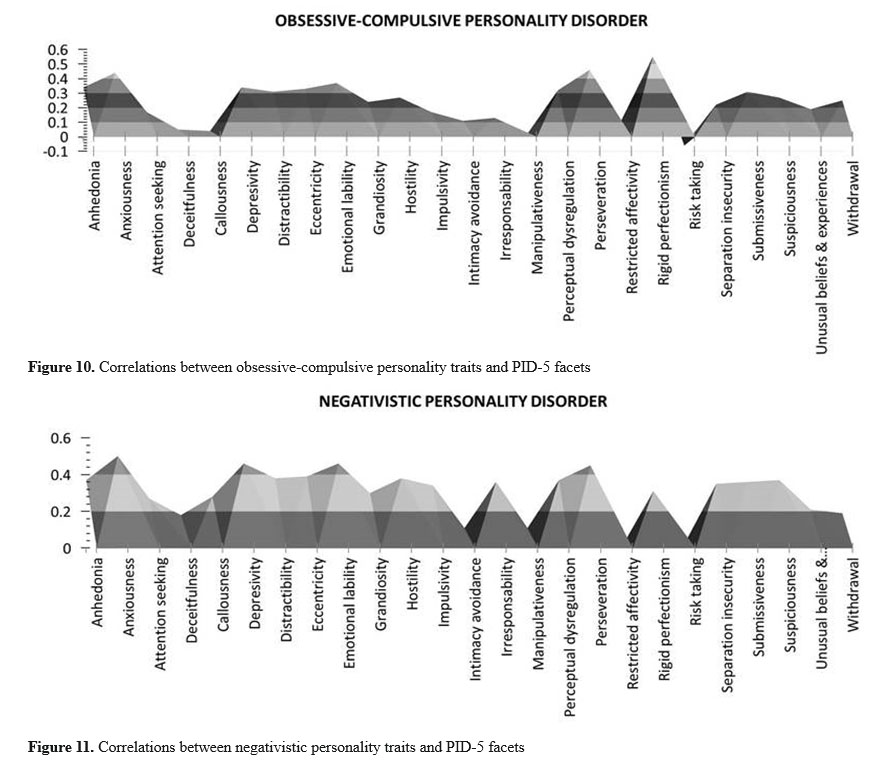
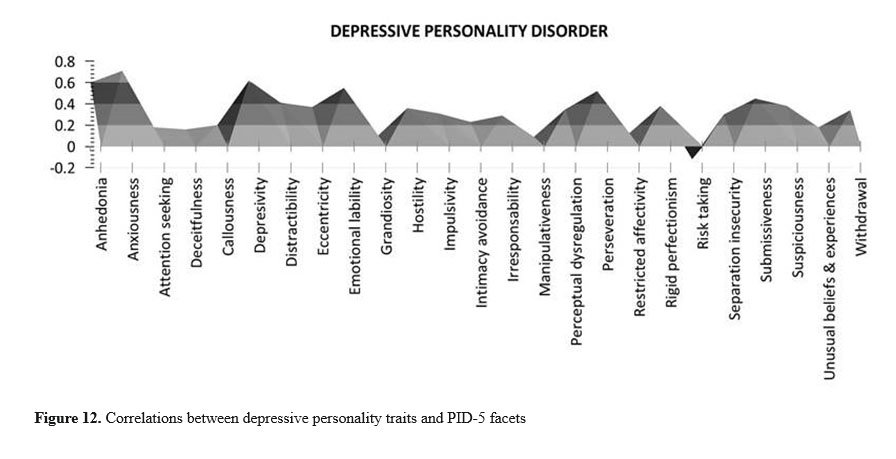

DISCUSSIONS
As shown above, the 6 personality disorders described in DSM-5 through the facets of the alternative model are consistent with our results.
Paranoid type traits can be described from the perspective of this model with the following trait facets: Suspiciousness, Perseveration, Rigid perfectionism and Anxiousness; Schizoid type traits: Withdrawal, Intimacy avoidance, Anhedonia and Restricted affectivity; Histrionic type traits: Attention seeking, Emotional lability, Impulsivity and Deceitfulness; Dependent type t r a i t s : S u b m i s s i v e n e s s , S e p a r a t i o n i n s e c u r i t y, Anxiousness and Depressivity; Negative type traits: Anxiousness, Depressivity, Emotional lability and Perseveration; Depressive type traits: Anxiousness, Depressivity, Anhedonia and Emotional lability;
CONCLUSIONS
The alternative model and PID-5 inventory have demonstrated once more, by their complexity, the importance of the dimensional approach of personality disorders. PID-5 inventory’s reliability provides safety to specialists in their personological assessment. The great prevalence of the 6 personality disorders unrecognized as standalone entities in the alternative DSM-5 model, especially in respect to histrionic, paranoid and schizoid personality disorders, suggests us a reevaluation of this simplistic approach of the connections between the categorical model and the dimensional one.
REFERENCES:
1.APA, A. P. DSM – Diagnostic and statistical manual of mental disorders – fifth edition. Washington DC: American Psychiatric Publishing, 2013
2.APA, A. P. DSM – Diagnostic and statistical manual of mental disorders – fourth edition text revision. Washington DC: American Psychiatric Publishing, 2000
***




